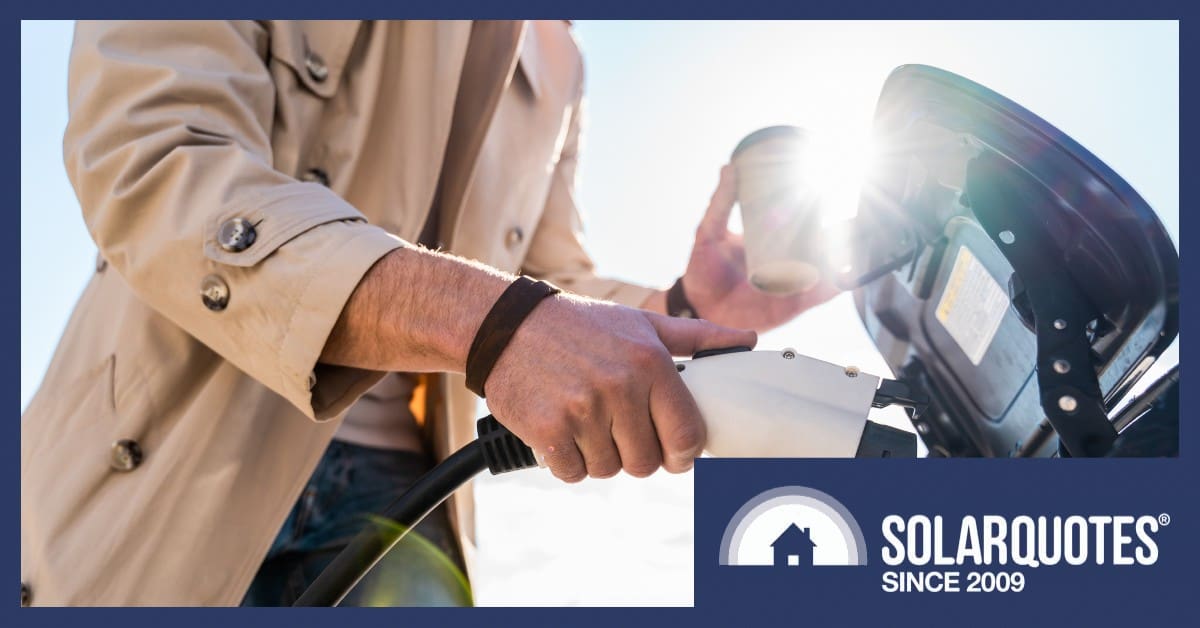 What if told you there was a petrol station selling half-price petrol?
What if told you there was a petrol station selling half-price petrol?
Forget the dollar figure, just imagine the traffic chaos and thousands of manhours wasted queuing.
Read on and we’ll explain how to get cheap fuel dispensed with zero effort from the convenience of your own driveway… it’s an absolute no brainer.
Of Course We’re Talking About Electric Vehicles
They’re perhaps more accurately described as storage with a steering wheel, transport appliances or passenger batteries.
No matter which way you look at it, EVs are large batteries, they allow you to store free energy AND eliminate your petrol bills.
While compliant, warranted and well-installed home batteries cost around $1000/kWh, a 39kWh Nissan Leaf can be had for $35,000… the battery is cheaper, and you get a free car!
Plus, there’s the fact petrol is hellishly expensive compared to grid electricity as a motor fuel.
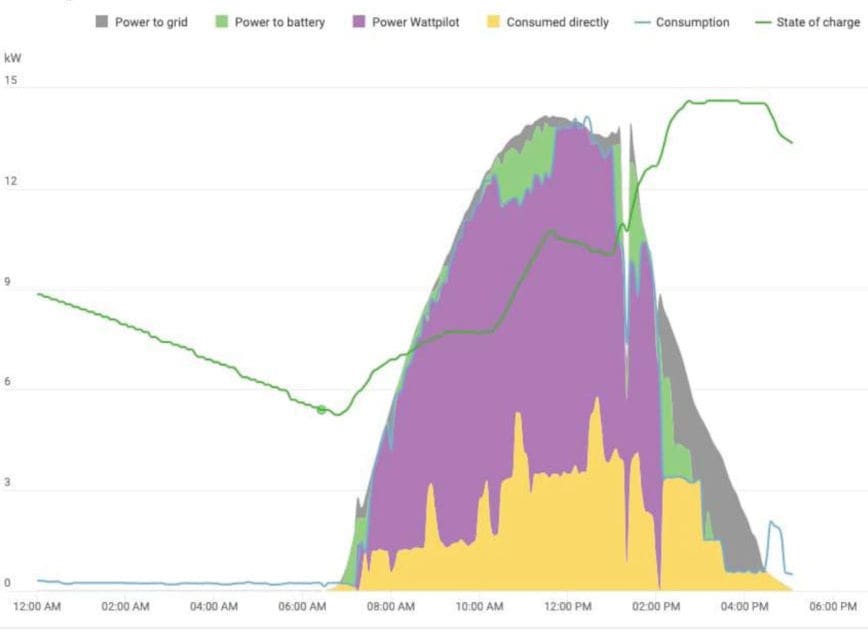
In this complex graph we see real time, self consumed solar in yellow, with almost all the solar energy available captured. The bright green is yield stored in a house battery, and purple represents charge to fuel an EV. In both cases these batteries are charged by “smart solar” that follows the inverter output without importing any energy. Only once both these vessels are full of sunshine, does the grey area show export of excess energy to the grid.
Is The Fuel Really Free?
Well yes, more or less. It can depend on how ruthless you are in counting beans but we’ll explore a few figures here using a rough average of 15kWh consumption for 100km travelled.
- A reasonably efficient car burns petrol at 10 litres/100km. By the time that fuel has been shipped halfway across the world it is $1.85/litre. 10 x 1.85 means the fossil industry has consumers well-conditioned to pay $18.50/100km.
- The most expensive electricity dispensed at highway fast chargers can be up to 80c/kWh. However Evie Networks provides very fast 350kW DC charging at 65c per kWh. Highway food might be bad and expensive but road trips are now much cheaper. 15 x 65c equates to $9.75/100km.
- Some slower EV chargers are used as loss leaders to attract customers to a winery for instance. Others like Jolt offer your first 7kWh for free, which is more than half a tank of fuel in my adorably modest EV. However, in traditionally expensive South Australia I’ve recently paid 25c/kWh. So CBD parking may still be a ripoff but charging while you’re at work isn’t. 15 x 25c equates to $3.75/100km.
- If you’re very lucky there are retailers paying 12c/kWh for energy you export to the grid. Forgoing this credit on your account means you “pay” 12c/kWh for storing energy. So at worst, home charging from solar is still less than a tenth of the cost of petrol. 15 x 12c equates to $1.80/100km.
- If you live in Victoria your retailer may be particularly scummy and only offer the mandated minimum 0.04c per kWh. At this point solar yield is almost free energy. 15 x 0.04c equates to 0.6cents/100km.
What About Sunk Costs?
If you invest $1 per watt installed, or $10,000 on a 10kW system, it should yield around 40kWh/day. Over 20 years that yield will have cost about 3½ cents/kWh, which considering inflation, is a lovely steady number.
- So it’s not unreasonable to say home grown energy to fuel your transport needs is 3½c/kWh. 15 x 3.5c equates to 52½cents/100km.
I’m not about to calculate the opportunity cost of missing a perfect ponzi, crypto, stock market investment where I could have better invested my money using 20:20 hindsight, personally I’ve got more interesting grass to watch growing.
However, if you’ve installed a 10kW solar power system which has a fixed 5kW export limit, your yield can be wasted by curtailment.
This is the worst kind of waste, where you’ve paid the money but the energy simply cannot flow to anywhere useful.
If we assume the worst case where your bell curve of potential is reduced to an Uluru of practical execution, there could be 13% of the energy you have paid for up front simply not coming to fruition.
While it’s raining down on your roof, curtailment sees energy pour down the drain. Using storage means you’ve captured truly FREE energy.
To start, the simple way to explain what I call a sunshine circuit is simply to turn on a load when your solar has ramped up to a certain yield. Solar diversion is the common terminology, because you take electricty destined for export to the grid and divert it into your own storage or consumption.
Storing Solar Energy Will Save You Thousands
They say planting trees is best done 20 years ago, so you’d best start digging today.
As batteries are many times cheaper now than they were 20 years ago, storing solar electricity is increasingly viable economically.
We aren’t talking about seasonal duration, like a tank of heating oil or a tonne of wood for your combustion stove. Rather it’s a shift in mindset, a matter of gathering fresh energy every day and using it over the next night or two.
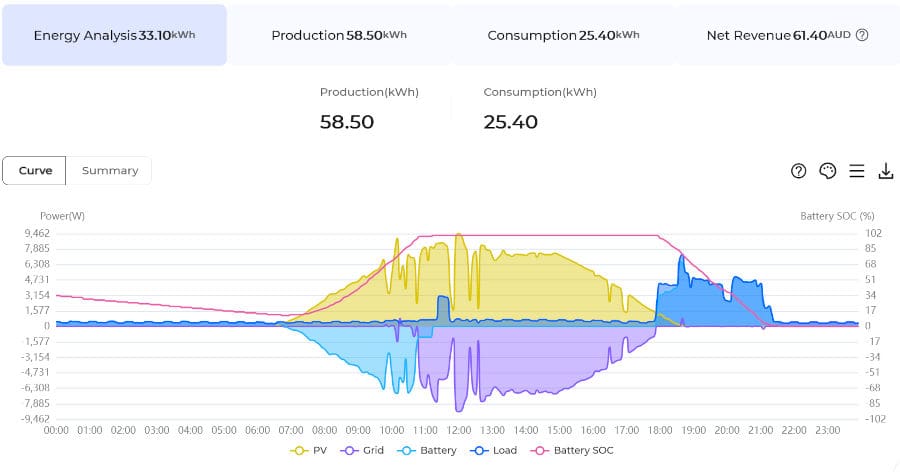
Here we see light blue turns to purple once the battery (represented by the pink line) is full. The major consumption of stored energy runs 6pm till 9:30pm. Next day we do it again.
It’s Time We Got Smart
When there’s abundant sunshine, then really, there’s no problem. Having lots of electricity available is a feature, “wasting” it with mid-summer curtailment is not a bug.
What we need is clever ways to generate and store energy when conditions aren’t so generous.
That’s why efficiency will always be king, especially in a long overcast week of winter. Insulation, double glazing, thermal mass, automation & clever design will pay huge dividends economically.
What’s harder for the accountants to quantify though, is comfort. Going home to a place you find relaxing improves outlook, lifts productivity & lowers anxiety.
As does slashing your electricity and fuel bills, in any case. To turn your home into a giant storehouse of free sunshine read our guides on solar panels, batteries and EV chargers.
Note: the original version of this article wrongly described Victoria’s minimum mandated FiT as four tenths of a cent, when it is actually 0.04c, not 0.4c. Apologies, and thanks to Les in the comments for the correction.

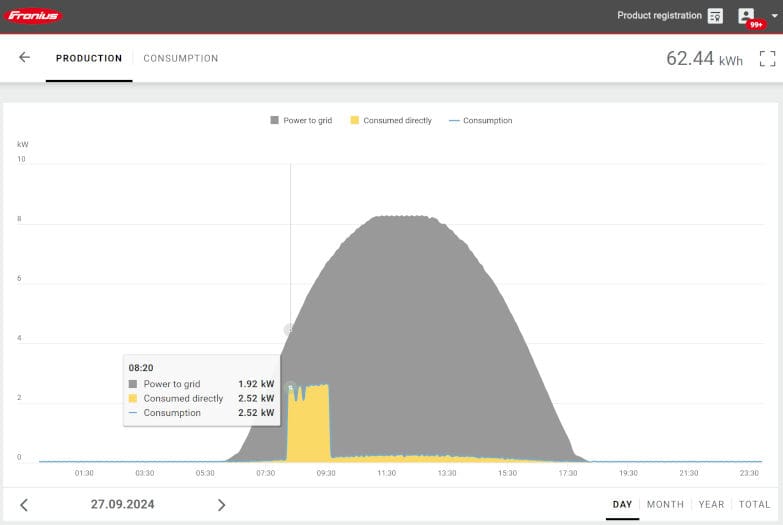
 RSS - Posts
RSS - Posts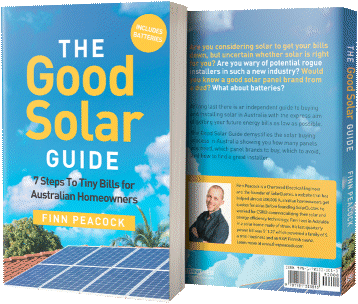


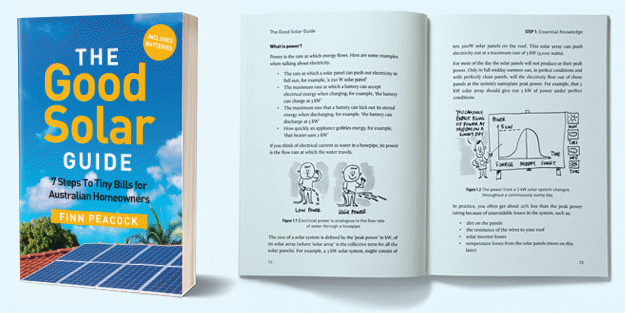
yeah,
but the problem is the greedy state governments looking to replace lost fuel excise and making lots of noise about a per km fee for electric cars, which, if truly replacing lost fuel excise, is going to run you about 80c a km travelled. This will far exceed the cost of power for charging your battery even at the most expensive price you mention.
That will make EV’s far less attractive.
Putting a battery on your house is still far better bang for your buck than an EV. Mind you as you say, buying the EV and putting it on blocks to act as a large battery might prove quite cost effective, whilst but buying one and running it down the road wont be saving you a lot.
Nobody will be charging 80c/km! That’s some social media fantasy fact gone rogue?
yeah, you might see i added another response saying i had a big mistake in there! Unfortunately if you dont see your mistake before you hit the submit button you are stuck with it, cant edit or delete your comment!
Hi Andrew,
We all make mistakes, feel free to call them out because the main thing is we’re here to learn. I’m glad I’m not the only one
Cheers 😉
I saw that you had, all good. I’m not interested in point scoring or gotchas!
The EV road user charge is another one anti-EV people have thrown out there to try to scare potential buyers off. My own brother, when I bought an EV and was telling the family about the huge savings in weekly energy costs, told everyone that the savings wouldn’t last, new EV road user charges would erase the difference. Something he’d seen online, somewhere. When I said any ‘EV tax’ that did that would have to be nearly $100 a week, in my case, he went a bit quiet.
sorry, missing zero there, my back of the beer coaster game is week today!! – about 80c per 10km for replacing the fuel excise! – which is no where near as bad as i thought.
Great article couldn’t agree more and v2g or v2h will be a game changer !!
The solar batteries make more and more sense. I understand the Electricity prices will increase with 9% from 1st July (Qld Southeast) and not to mention that the Solar export was recently reduced down to 4 c/KW.
Do you really want to export and get paid 4 c and to buy back electricity at over 35 c?
And yes 35 c is cheaper than $ 1.80 per L petrol..if you have a charger at home but even 65 c seems to be a bargain
And yes, the battery price have come down but still $ 1,000 per KW..not many people can fork this amount of money upfront..Just food for thought..
Ilian, it depends how far that litre of petrol gets you compared to the kwh of power.
Working on 14,000km per year.
Small petrol car with use of say 8lt/100km = 1120lt @ your $1.80 suggested = $2016 fuel cost (plus a service $200 or so).
A typical EV efficiency of 17kWh/100km is about 2,400kWh per year @ 0.35c/kwh = $840 energy cost, (no service cost).
Very good there for sure, now when you look at charging from home of PV being $0, well, that looks even better for suburban use 🙂
Yes, we are probably (these were suggested rises from the AER, not yet approved) in for more power pain in some of the NEM states / regions, SA also looking at another 5.1% increase too, which will bring peak tariff to just under 52c/kwh.
A small EV is more like 12-13 kWh per 100 ks, 17kWh is an SUV or large sedan.
But you also need to take into account charging loses.
Anyway you don;t need solar to run a an EV for cheap, just go on a EV plan with free hours during midday and cheap rates over night.
Then it is bascially free not matter how thirsty it is.
“If you live in Victoria your retailer may be particularly scummy and only offer the mandated minimum four tenths of a cent per kWh.”
Anthony, I read of this Vic proposed 0.04 of a cent feed in sometime ago, likely here on solarquotes.
That is actually 4/100 of a cent.
I thought it might be an actual typo ow way they presented the figures in para 2 here . . .
https://www.esc.vic.gov.au/media-centre/regulator-releases-draft-decision-solar-minimum-feed-tariffs-2025-26
But when they later say down from 3.3c, you know they really do mean 0.04 of 1c, ie 4/100th of a cent.
Now this is the proposed minimum, it remains just how many retailers would be willing to push that button first.
But if one or two jump on it, the rest will likely follow.
Goes to show FITs are going to be gone everywhere in the coming year or two, and how important using and storing as much production possible has become.
Fixed – thanks for catching this Les.
Cheers Max.
I still think the Vic regulator info is wrong somehow, or at the very least poorly presented.
When is 0.04c down from 3.3c ?
It says clearly “The proposed minimum flat feed-in tariff is 0.04 cents per kWh starting 1 July 2025, down from the current 3.3 cents per kWh in 2024–25.”
I’ve seen references to 0.04 of a cent too, which is 4/100th of 1 cent, but then while that works with the ‘down from 3.3c’, if correct, they should have written that as the same format as other c/kwh quoted, ie 0.0004c/kwh.
Then a link from the previous main page above, it’s all different again !
https://www.esc.vic.gov.au/electricity-and-gas/prices-tariffs-and-benchmarks/minimum-feed-tariff/minimum-feed-tariff-review-2025-26
Stating choices, inc a flat rate 0.04c /, other variable options both with some periods of 0.00 FIT paid, and obviously a VPP type FIT for those with a battery through the night that want to contribute.
It’s all a bit confusing for consumers, like power plans can be . . . maybe by design.
The maths is still wrong on this line:
“minimum 0.04c per kWh. At this point solar yield is almost free energy. 15 x 0.04c equates to 6cents/100km.”
Current FiTs are 3.3c / kWh
Proposed FiT 0.04c / kWh
Therefore
Current FiT foregone for 100km = 0.03 * 15 = $0.45
Proposed FiT foregone for 100km = 0.0004 * 15 = $0.006 (or .6 of a cent)
qed
Cheers Andrew,
Looks like you and I both could use better proof reading 😉
We opted for a Powerwall 2 about 3 years ago, when having solar installed, and many friends thought it was a crazy decision, not ‘cost-effective’. But at the time, and it’s proven to be have been a good call, what appealed to me as much as storing solar-generated excess was also being able to make use of cheap or even free grid rates, as well as protect against climate-driven outages (the number of which grow every year in my area).
Now the battery is the most interesting part of the whole home energy system. We have 3 energy sources, solar, supercheap (8c/kW) grid power and free grid power. I don’t even use peak grid, the battery has allowed us to avoid it pretty much all year. At first I used Tesla’s excellent app to manage the automation of the multi-component system (which also includes an EV), but now I find NetZero’s built-in automations are by far the most useful and powerful.
Have you done an article on NetZero’s automation options? They’re superb (I think). Can avoid using any battery storage for EV charging, set a whole smorgasbord of conditional chanrging and discharging options etc.
I’d like to see the NetZero info too Nick, it sounds like it would work well, and not require other controls like Catch Power.
Is there a subscription or just an outright cost ?
NetZero is free, can download it any time. All the automations are built into the app, and you have almost limitless permutations across battery, solar, EV etc.
Cheers Nick, will take a look when we get onto a battery (or EV).
No problem, it’s only for Tesla Powerwalls, from memory.
Hi Anthony, I agree with the logic of your article and it is in the same line of my thinking to proceed. I do have a 15 kW solar system tith a 19 kWh battery. We running on the hot days here in victoria up to 12 at night the AC to cooldown the house and the battery is not drained by the next morning even if we use the heat pump to boost the hot water for the morning showers. Similar to your system, graphs above, at around 10:00 to 11:00 the battery is fully charged for the next cycle.
The stats that I saw quote about 20 kWh for 100 km but it most probably depend on what car you have. I am looking at the HAVAL from GWM. It have a 34 kWh battery and they claim 180 km range, it is a HYBRID.
My problem now is the winter here in Victoria, I am sure that there will not be enough sunshine to charge the battery. There is not enough wind around to install a wind charger and I am not interested in a generator. I am thinking very hard for en energy solution outside the grid. Perhaps thermal?
Hi,
If you are considering buying a Chinese car, make sure that is uses CCS2, and is capable of bidirectional charging, or you will end up in the same situation I’m in.
And what is your situation?
Hi,
A Nissan Leaf e+ with no way of making use of the battery as solar backup.
Solar to charge EV is great is retired or WFH, but if you commute to work, then you’re not plugged in during solar peak. A short commute might be covered by a home battery, but that’s a big investment for limited ROI. There was an attempt to be able to send code with packets of electricity, so in theory you could plug in anywhere and withdraw a proportion of the power you send to the grid (not the actual electrons generated), but a form of trading at some nominal fee – while technically possible, it was a bureaucratic nightmare.
Hi,
For those who commute to work there is a simple solution. Many familes nowadays are two car families. If both cars are electic, then you drive each of them to work on alternate days. The day that a car is not being driven it can stay home and recharge. The car that is at home recharging can still be used to go shopping, or for emergencies, which is usually only a short trip, if need be, or the car that was driven to work can also be used to go shopping on the way home.
This will depend on the battery size. My car (BYD SEAL) has 80 KW. I drive 60-70 km a day and the battery can last me at least for 7 days. So once a week charge is enough for me. If you have two electric cars you can charge the second on alternative day…
I keep my Tesla charged at 80% for battery life. But it hasn’t been an issue, because I just use other peoples’ solar to do it if I’m not home, by accessing the supercheap overnight rates, or totally free daytime rates, to also top up the home battery.
Solar seems to encourage an every-home-is-an-island thinking about energy. The grid is a fantastic resource, and is chock full of renewable energy even when you can’t access your own.
I’d you are charging overnight you aren’t using other people’s solar, you’re mostly using coal
Hi Andrew,
In South Australia you’re more than likely using wind actually, followed by gas or perhaps imports from Victoria, which are again moving to wind as the Latrobe Valley coal burners are ramped down and retired.
The new off peak is now midday, so that’s where the cheapest rates are now and hot water will be turned on.
I agree that overnight rates are cheap, but that will change, because that power is currently mostly provided by coal fired power stations, which take a long time to stop and start, hence are kept running overnight.
Most of these are approaching “end of life”, so need to be replaced by something. If renewables are to be the primary replacement, then some form of storage will be needed. It would seem logical to use EV batteries as the backup storage, as they would be more than adequate, and likely also the cheapest measure, given that they are “dual function”. IOW if the vehicle fleet is moving toward EV’s anyway then it makes sense to use that capacity as backup.
Hi Nick,
Where do you get “totally free daytime rates”?
Hi Anthony,
Yep, agree with the midday peak being the time when we should be shifting as many loads as possible. In the eastern states (where most of us live) coal is typically 70-80% of the overnight generation compared to the day when it can be down around 20%. It’s a deal with the devil: do I take that cheap overnight rate knowing that by doing so my emissions will be much higher than the more expensive day rate (if you care about such things).
Hi,
People in this situation might consider asking their employer to put solar panels on the roof, so that EVs can charge in the parking lot at work.
There may be a counterpoint to this. Tesla operated at a loss from its founding in 2003 until 2020. Partly because of this, and especially due to green energy tax breaks passed by Democrats, the billions in tax Democrats now think Tesla should be paying, don’t actually need to be.
(https://legalinsurrection.com/2025/03/the-reason-why-tesla-pays-so-little-in-taxes-will-infuriate-sen-warren/)
Australia is obviously not America. There are no EVs manufactured here, there’s not even any full battery or solar panel manufacturing – assembly yes (Red Earth, Tindo etc), but not full manufacturing from ‘mud’ to finished product, but there are taxpayer funded incentives to buy solar stuff.
Does the full cost to taxpayers outweigh the benefit? Different people will have different answers. Worse, much of the accounting tricks and tax benefits probably won’t be known.
For those with low mileage, and low petrol or diesel bills especially, whatever benefits EVs may offer in theory, remain surpassed by the benefits of traditional petrol stations.
That being said, Google Trends data apparently shows that searches for buying Teslas have soared to record heights in America, while the broader EV market remains sickly at best.
IMF figures show the world subsidises fossil fuels to the tune of over $7 trillion every year. And when the end-vehicle is at least 3 times more efficient to run, there’s never going to be any sort of contest at the collective level as to which is the cheaper way to go.
Absolutely some people will not save money given their current use case. But ICE vehicles will eventually dry up, no carmaker is really committed to continue making them, so the legacy clunkers in the system will eventually be phased out.
That’s a highly misleading figure. It’s specific to 2023 – energy prices spiked due to Russia’s invasion of the Ukraine, and COVID recovery. The problem is the subsidies IMF report are garbage.
Explicit subsidies are supposedly undercharged supply costs. No clue how they determine, or imagine, those.
Implicit subsidies are undercharging for environmental costs – basically nil, but they want to charge for imagined global warming contributions. They also want to charge for foregone consumption taxes, but again they don’t specify what tax was foregone – is it reduced excise because of the crisis, or failure to levy the ‘approved level’ of tax? They also mention carbon pricing, which only exists in a few countries. Are they applying some sort of universal standard?
In short it seems like imaginary costs based on what anti-fossil fuel folk believe people should be stung for but aren’t paying. Anyone can make such arguments, but they have no basis in science.
(I doubt this correction of your IMF disinformation (or is it misinformation?) will get past SQ, but one can always hope facts and truth win out).
Hi George,
Seems everyone gets upset when they’re just making assertions.
I really like the last link on this list because the notion that fossil fuels are subsidised rings true.
Take coal for instance, coal isn’t cheap.
SA Health statistics have confirmed Port Augusta has double the number of cases of lung cancer than the expected state average, according to official figures cited by Health Minister John Hill.
Coal is only profitable when it doesn’t have to pay for the damage it does.
Its the people, the workers, the nearby residents and the kids downwind, they subsidise coal;
with their very lives.
https://www.adelaidenow.com.au/news/south-australia/port-augusta-is-sas-cancer-hotspot/news-story/d2ed7532527bf669df9666b933dc7cd9
https://www.amsj.com.au/black-lung-parliamentary-inquiry-kicks-off-today/
https://www.npr.org/2022/04/13/1092690291/researchers-say-theyve-linked-silica-dust-directly-to-severe-black-lung-disease?
https://www.abc.net.au/news/2019-02-26/dozens-of-new-black-lung-cases-qld-advocates-say/10851482
https://www.qao.qld.gov.au/reports-resources/reports-parliament/addressing-mine-dust-lung-disease
https://www.newcastleherald.com.au/story/5950821/piper-backs-independent-review-of-damning-lake-macquarie-report/
https://www.abc.net.au/news/2019-03-11/crabs-lake-macquarie-nsw-contaminated-with-cadmium/10887750
https://www.theguardian.com/australia-news/2021/jun/29/hazelwood-coalmine-fire-has-had-lasting-health-effects-on-latrobe-valley-residents-study-finds
https://en.m.wikipedia.org/wiki/Kingston_Fossil_Plant_coal_fly_ash_slurry_spill
https://www.wkyufm.org/2022-12-01/kentucky-coal-ash-is-contaminating-groundwater-but-companies-argue-theyre-in-compliance
https://www.npr.org/2022/10/17/1128354266/coal-companies-use-bankruptcy-and-asset-transfers-to-shed-obligations
https://www.nsenergybusiness.com/news/us-coal-company-bankruptcies/
https://electrek.co/2019/12/18/bob-murray-science-denial-instead-coal-workers-wages-bankrupt/
Imagined global warming costs?
Nil environmental costs?
Ay caramba.
Hi,
I have a Nissan Leaf e+ and would absolutely love to have V2H. Unfortunately, it doesn’t look like it’s ever going to happen. Finding the necessary hardware is proving extremely difficult.
So if someone knows of any, that doesn’t involve also spending money on an unnecessary Lithium ion battery, then please let me know.
Ideally it would be a DC coupled hybrid inverter.
(Quasar wallbox 1 is no longer available, and IMO was too expensive anyway.)
I have been running a Kona for 4+yrs, & now 137Kkms. Keeping in mind the first 2 years were free NRMA charging, most of our charging is off the PV. We have spent under $1000 on public chargers.
Our house has 3 households, so 3 fridges, & 2 Induction cooktops. H/W is solar Edwards, & our total power bill is between $100 & $150/month, including charging both EVs (the other is an Imiev shopping trolley!) We have a Zenaji 12Kw battery we purchased about 4 yrs ago: Lithium Titanate, & gets discharged every night to offset the peak power cost. Usually flat by 8pm.
I try to charge during daylight but sometimes it is not possible if we come home & need to leave early the next day.
As far as the article being realistic, I would have liked to see Kona EV compared to Kona Petrol. I guess Kona petrol = 8L/100Km? My Kona EV on Eco mode uses 13>14.5Kw/100 on the highway. If I am in traffic it is the lower #, but by yourself 14Kw/100. I find tyres are important: Continental Eco6s are better than my last Bridgestones by about 1Kw/100. I look for the lowest Rolling Resistance in my budget, but wet & grip important too.
Next, where did Andrew get his figure of 80c/Km?? The only figure I have heard about is 2.5c/Km. On my figures, this means EVs are still at least 25% cheaper to run than an average similar sized Dino powered vehicle. If we also compare servicing, the TCO of an EV easily tramples on the Dino Dinosaurs! (50% less for average service, virtually no consumables, & no motor bits to wear out. No overheating either.)
Robin, I think there will be an EV isolation solution coming that might allow vehicle hook-up to the grid. The issue atm is that our market is so small that manufacturers will not spend the $s to adapt their vehicles to our Energy compliance requirements. I feel the V2L with an isolation solution might be the answer until our market grows. 3.5Kw is not unreasonable for household use: it will certainly reduce peak usage.
Hi,
I’m not really a fan of V2L for household use. These cars have a wall socket somewhere in the vehicle, and you would need to run an extension cord into the house. It’s both a manual procedure (so not automatic and hence can’t be computer controlled) and also inconvenient. Furthermore, I doubt it is bidirectional, though I haven’t really checked that.
I think what is really needed is a hybrid inverter that can “talk” to the EV with a DC connection. This solution has the lowest component count, so should be the cheapest overall. When the sun is shining, it can charge the EV with excess power not being used in the home. As soon as the power output of the panels drops below a threshold value, the MPP tracker(s) can be switched to the EV to convert the DC from the EV battery into AC for the home (&/or grid). This process can be completely automatic, and transparent to the householder. It also makes dual use of the MPPT(s), thus reducing the component count. EVs & panel strings have about the same voltage.
Inverters already meet the grid connection requirements, so on that front nothing should need to be done. The EV connection is “behind” the inverter as far as the grid in concerned. IOW the EV simply replaces what would otherwise be a stationary battery. Personally, I think inverter manufacturers should offer models with exchangeable modules suitable for a variety of EVs, but Standards Australia seems to have settled on CCS2 much to my disappointment. I would have preferred that they leave that open to choice.
OTOH, I suppose some standard is better than nothing at all.
Note that such an arrangement automatically takes grid failures into account and should keep on supplying power to the home, without any human intervention required. If/when there is no EV connected to the system, solar/grid power is still available, though that might require a small stationary battery (e.g. 1 kWh) to stabilize the panel output during the day.
Hi Robin,
Many EVs use the charging port to export energy via a modified handpiece and short lead with a powerboard or a fairly weatherproof screwed female socket.
Combined with a HOEM device and it’s a pretty straightforward arrangement to run your fridge, lights, internet and maybe a small air conditioner too.
It’s not bi-directional but it’s not inconvenient either… and it’s available right now.
There’s probably a million family second-vehicle shopping cars in Australia. If they all went BEV, the climate benefit would be starttling, maximised where rooftop solar does the heavy lifting.
When my 25 yo ute blew up, I bought an MG4, highway range 300 km. It’s done 9,000 km in a year or so, saving around $1,665, not counting the substantial servicing savings. Retired, I do that straight off the roof, so no grid or battery cost.
But if I had to use the domestic battery as intermediary, due to being out all day, then what is the battery payback? The 46 kWh of LiFePO₄ house battery is overkill, so let’s allocate 30 kWh to BEV time-shifting. That’s $12,000 cost / $2700 p.a. fuel cost saving = 4.44 yrs payback. If you did the same with six 5 kWh rack mount batteries @ $2700 each (coincidence), that’s six years payback. If you did the typical 15,000 km p.a., then the payback is very rapid.
Oh, I *love* Robin’s two-BEV formula; swap which one stays home on alternate days. That’s brilliant.
Hi,
The Australian population is about 26 million. The average family size is somewhere between 2.5 and 3, so there are about 10 million families. About 60% have two cars, so that’s about 6 million “second cars”.
While the broad thrust of this article is correct 10l/100km isn’t a fuel efficient car. Even my 8 year old outlander does 6.5.
Hi Craig,
It would be great if more people could achieve that but have you seen how many Blandcruisers, dual cab 4wds & other trucks are getting groceries or doing the school run these days?
https://www.bitre.gov.au/sites/default/files/is_091.pdf?utm
So for $35000.00 you can turn unsalable surplus solar into cheap mobility, provided the car is able to be at your house during the day, or you could purchase a $1000.00 resistive storage HWS and get a much better bang for your investment, without having to worry about where to park it.
Of course there are still some who think we should still go for heat pumps because of their efficiency, but I have read recently, on good authority,…..
“But when your power is coming from the sun, there’s no fuel. We’re not short of sun. It’s not really wasting it.
“Worrying about wasting surplus solar energy is kind of like worrying about the rain coming out of the sky when your rain tanks are full.
A great added benefit by oversizing your solar to the max is the greater amount of your own solar is available on those cloudy or early or late times when a small system still needs to be supported by high priced peak power,
My car is never parked at home during its commuting week. In conjunction with a battery and cheap and free grid rates, it hasn’t mattered. The entire house and vehicle are costing me 50 cents a day to run.
Do these figures include the cost of vehicle to home chargers?
We are retired and will probably need to downsize relatively soon so installing a battery system is prohibitive. We compromised by buying a Bluetti system, it didn’t quite manage what we were using when we had a 6 hr. outage, and had to resort to the generator, which we”ve sold so we bought a bigger Bluetti. We use the smaller system to run the garage fridge on timed ups, the bigger unit is in the house running the freezer. Inconvenient with extension cords in the event of a power outage, or when we go away but better than a smelly freezer.
Our electricity costs are still modest due to 9 kw of solar on three phase to the house. even air-conditioning is evaporative and a split system for heating HW is rooftop solar which rarely consumes any power for nearly 6 months of the year. and is on controlled load.
Currently no EV can tow our 20ft caravan for a reasonable distance and we have no need for second car.
Hi Stewart,
There’s a cheap alternative to full bi-directional EV charging called HOEM. If you get an EV with Vehicle to Load capability then you can both power the caravan and power your basic home appliances with it.
I’d be interested to know how you get on with the camping battery setups as I think these might be popular with renters.
I don’t know what your caravan looks like but if you follow “Atto Gal” it might give you an idea of what’s possible with an air conditioned van that also serves as a self filling jerry can.
https://www.facebook.com/profile.php?id=100089625813396
Hi,
Quote:-
”
The bit that confuses me was the RedEarth announcement stated (bolding mine):
“The ambibox EV chargers produced by RedEarth are three phase compatible wall chargers that have been successfully tested with the vast majority of EVs available in Australia.”
My understanding was to use an EV’s battery to export to the grid you need a bi-directional charger *and* an EV that supports V2G functionality.”
———
AFAIK RedEarth already sells chargers that are not bidirectional, and I suspect that the ambibox quote above refers to those.
The caravan is a 20ft full height van. It weighs about 2500 kg loaded, we don’t free camp, and use caravan parks.
Towing with a diesel Pajero Sport we use about 16 ltrs per hundred km. Not really comparable with Atto. My thoughts are we’d get no more than half the range of even less with the current ev tow vehicles.
We don’t take the bluettis with us they are just backup at home for power outages, becoming more frequent as the local infrastructure ages and more homes in new developments.
We never buy coffee or snacks at service stations, prefering to carry our own,so waiting to charge would be painful.